Bus Stop Urban Design 
Introduction |
Literature Review |
7 Goals |
9 Techniques |
Selection |
9 Designs |
Bibliography
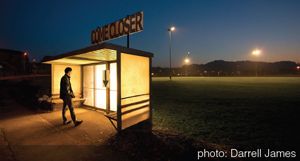
3.1 Safety
CPTED measures and accessible design reduce the risk for crime and accidents. Natural surveillance through design is preferred.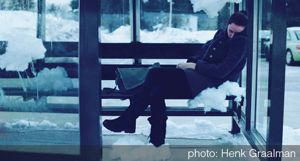
3.2 Thermal Comfort
Thermal condition is the most important factor determining comfort. Passive and active controls can be used to maintain desired temperature range.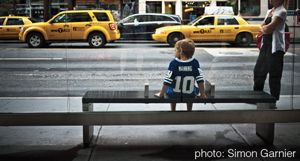
3.3 Acoustic Comfort
Traffic noise negatively affects both riders and adjacent residents. Elements should be arranged to best shield or absorb noise.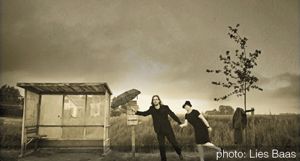
3.4 Wind Protection
Wind can have both mechanical and thermal impacts on the transit rider. Wind should be carefully mitigated as its cooling effects may be desired.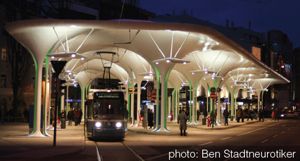
3.5 Visual Comfort
Sufficient lighting should be provided for safety and to conduct productive activities at a bus stop. Excessive light such as glare should be minimized.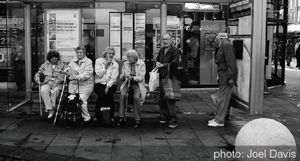
3.6 Accessibility
The transit stop should be easily accessed by all segments of the population, of all physical abilities, and through all active modes.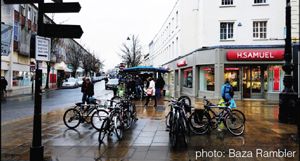
3.7 Integration
Being nodes within neighbourhoods, transit stops should also cater to the needs of their surroundings and reflect the identity of the community.3.1 Safety
In a survey of transit riders and confirmed by many other studies, safety is consistently ranked as one of the highest priorities at a transit stop (Taylor et al., 2007). It is understandable that personal safety is the basis upon which all other improvements can be made. Without an adequate level of perceived safety, commuters will simply choose not to use the transit stop (Nabors et al., 2007). Issues of safety may result from criminal activity or physical hazards, such as high vehicular traffic or slippery surfaces. It is important to note the differences between perceived risk and actual risk, which may be correlated or inversely correlated depending on the type of risk (Cho, Rodríguez, & Khattak, 2009).3.1.1 Risk of Accident
Risk of accidents at a transit stop is usually associated with pedestrians being in close proximity to heavy or fast vehicular traffic (Tan, Wang, Lu, & Bian, 2007). To ensure the safety of commuters, adequate pedestrian protection must be provided. Strategies that have proven effective are more traffic lights, crosswalks and barriers between modes of travel (Rodríguez, Brisson, & Estupiñán, 2009). Traffic calming techniques that slow down vehicles are also beneficial. However, most traffic calming programs in North America have not fundamentally shifted their emphasis towards the needs of pedestrians, bicyclists, and the town environment (Ewing, 2008). One particular take on traffic calming is the concept of shared space, in which separations (curbs, lines) between travel modes are removed, encouraging eye contact between all users (Hamilton-Baillie & Jones, 2005). Studies show these areas have lower accident rates because when there is higher perceived danger, people will act more carefully, resulting in a safer environment (Kaparias et al., 2012). This strategy is worth investigating, especially for locations with multiple bus stops and in high density areas.3.1.2 Risk of Crime
Crime in public spaces occur mostly because there exist windows of opportunity (Saraiva & Pinho, 2011). Therefore, reducing these opportunities is the preferred method for reducing risk for crime around transit stops. While increased surveillance by transit police and cameras are options, they may cause excessive target hardening and lead to a fortress mentality (Saraiva & Pinho, 2011). Many have pointed out that measures to keep out “undesirables” cause more detriment to a public space than the original problem (J. Jacobs, 1961). Crime prevention through environmental design (CPTED) is a popular school of thought that focuses on natural surveillance (Susilo et al., 2012). Natural surveillance refers to creating a safer environment through means that also make the space more welcoming. Strategies for transit stops include making the space easily observable from the surrounding, avoiding hiding spaces, ensuring sufficient lighting at all times, and maintaining station upkeep (Nikolopoulou, Kleissl, Linden, & Lykoudis, 2011; Saraiva & Pinho, 2011).3.1.3 Individual Perceptions
Individuals will evaluate the risk of an area based on their own attributes such as age, gender, and familiarity with the area. Studies show that commuters who are older, female, and new to the area have lower thresholds for what is considered a safe environment (Leslie et al., 2005). Residents of transit stop catchment area and those who walk around the transit stop area for exercise are found to be less affected by the perceived risk of traffic accidents and crime (Humpel et al., 2004; Owen, Humpel, Leslie, Bauman, & Sallis, 2004). Such findings are beneficial in refining the amount of CPTED measures required to ensure a safe environment for commuters.3.2 Thermal Comfort
Surveys of transit stop users show that overall comfort is determined primarily by the thermal environment (Nikolopoulou et al., 2011). In areas of extreme heat or extreme cold, it is important that the designer develop a level of "radiant" sensitivity (Scudo, Dessi, & Rogora, 2004). At the transit station level, the microclimate is determined both by regional factors such as solar gains, local factors like the urban heat island effect, and site factors like surface temperatures (Kleerekoper, van Esch, & Salcedo, 2011; Scudo et al., 2004). As a result, it is important to consider the ventilation of the site, albedo of materials used as they affect the overall thermal environment (Asaeda & Thanh, 1996). Ambient temperature is found to be one of the strongest factors for both men and women choosing to walk when other modes are available (Owen et al., 2004). A temperature of 24 degrees Celsius is most desired by those waiting outdoors (Chun & Tamura, 2005). While 24 degrees is ideal, people are found to be more accepting of variations in outdoor environments. In general, comfort range for commuters is +/- 3 degrees Celsius in the winter, and +/- 10 degrees Celsius during other seasons (bin Saleh & Pitts, 2004). Another major factor in determining the comfort level of a stop is past experience. People's perceptions of what is comfortable is often set by their past experience in that location (Chun & Tamura, 2005). Even when thermal conditions are not ideal, people will engage in adaptive behaviours up to a certain point, such as drinking cool fluids or adjusting clothing (Katzschner, Bosch, & Roettgen, 2004). While thermal comfort is of primary concern at a transit stop, there is no need for narrow range HVAC systems in most circumstances due to these adaptive behaviours (Chun & Tamura, 2005).3.3 Acoustic Comfort
While important to the overall comfort of the commuter, the acoustic environment is often least discussed (Kang, Yang, & Zhang, 2004). Sound in urban spaces can be categorized into keynotes and sound marks, more commonly referred to as background and foreground sounds respectively (Schafer, 1976). Background sounds can consist of traffic and other urban noises, while foreground sounds usually relay information, such as crosswalk rings and announcements. In public spaces, people will be accepting of noise levels between 40-70 dB, up to a maximum of 73 dB (Giddings et al., 2011; Yang & Kang, 2005). However, as with temperature, people can tolerate variations depending on the situation. Pleasant sounds like as birds songs, live music and sound of water can create acoustic comfort even when noise levels are high (Kang et al., 2004). It is also found that acoustic comfort interacts significantly with other factors. For example, if a transit stop is particularly visually pleasing, this can equate to a 10 dB reduction in noise (Kang et al., 2004). Finally, it is important to note differences in audience. Commuters may have different cultural and personal preferences to sound and music (Yang & Kang, 2003). Also, residents who live close to transit stations are likely to have much lower tolerances for noise as they are not in an outside environment.3.4 Wind Protection
The effects of wind can be divided into two main categories, mechanical and thermal (Penwarden & Wise, 1975). Wind under 5 m/s can be considered a light breeze and pleasant. Above 5m/s, mechanical and thermal effects can both be felt. At wind speed of 10m/s, walking becomes unpleasant (Giddings et al., 2011; Penwarden & Wise, 1975). Wind is a difficult factor to design for as it is welcomed in some situations and unwanted in others. Wind environment is also difficult to foresee and control because it is influenced by a number of global, regional and local factors (Gaardsted Esbensen Consulting Engineers Ltd., 2004). Similar to thermal conditions, data from meteorological stations cannot adequately represent the microclimatic conditions of sites as small as a transit station (Nikolopoulou, 2004). Such locations' wind environment is determined by its orientation to access streets, size of the urban space, height of its surrounding buildings, and objects in the area that acts as windbreaks (Gaardsted Esbensen Consulting Engineers Ltd., 2004). Therefore, the best solution is to provide a variety of spaces so that people may choose the type of environment that best suits them. Generally, it is ideal to keep both wind speed and turbulence to a minimum in public spaces.3.5 Visual Comfort
Visual comfort can be broken down into three factors: adequate lighting for desired activities, lack of glare or other uncomfortable visual stimuli, and points of interest for the commuter to focus on. While people are highly adaptive when it comes to the amount of lighting provided, they always welcome more light, especially sunshine (Compagnon & Goyette-Pernot, 2004). Studies also show that most visual attention is directed towards the open part of the site or towards some type of activity. This seems to be in line with other urban design theories that state people feel most comfortable being on the edges of urban spaces, looking inward on the action (Gehl, 1987). Another important measurement is the maximum distance between users that allows for face recognition, which is 24 metres. To ensure a comfortable visual environment during the day, the sun should reach between 20-80% of the site at all times (Compagnon & Goyette-Pernot, 2004). It is also shown that visual comfort interacts widely with other factors. Most notably, visually stimulating objects and activities in a location can compensate for many unwanted attributes, such as extended wait times and high levels of noise (Kang et al., 2004). Therefore, creating a visually comfortable and interesting environment is extremely beneficial, as it can both draw people to and keep people at a public space.3.6 Accessibility
Accessibility refers to the access of the transit stop by all segments of the population and through all modes. It is found that better connections between the neighborhood and the surroundings encourage individuals to walk or cycle more (Susilo et al., 2012). Assuming basic accessibility is met, such as minimum widths needed for pedestrian comfort (Tan et al., 2007), this section discusses possible avenues of improvement of access to expand a transit stop's area of influence (Reconnecting America, 2011). In particular, the specific needs of the elderly and families must be accommodated at station access points and loading points (TransLink, 2011). With growing popularity of active transportation, it is important to ensure that there is sufficient pedestrian and cycling network connectivity around the transit stop to serve these modes (Cole, Burke, Leslie, Donald, & Owen, 2010). Cycling infrastructure is especially important in and around suburban stops, as the distances travelled to transit are usually greater. As a result, commuters are more likely to cycle (2km to 5km) to transit if the option exists (Martens, 2004). Public education of the cycling network is also extremely important as commuters' tendency to cycle is associated with perceived access to bike lanes; many people are simply not aware of their existence (Larsen & El-Geneidy, 2011).3.7 Integration
Like any urban open space, transit stops can benefit greatly by being integrated with its surroundings in multiple facets (Gjerde, 2011). With cooperation from the municipality, transit agency, and adjacent land owners, it is possible to create transit stops that not only serves commuters, but also seamlessly connects with neighbouring activities (Wardman et al., 2001; Zacharias et al., 2011). The orientation of and amenities at the stop should be compatible with the surrounding establishments, whether it's providing extra surfaces for stops near grocery stores or appropriately sized seats for stops near elementary schools. Designers should also be aware that the use of the transit stop may vary between seasons. Therefore it is important that amenities underused by commuters can be repurposed for local users (Chrisomallidou et al., 2004).Integration is not only for the benefit of the neighbours. Studies show that being close to shops, catering establishments, and businesses contributed to the attractiveness of a transit stop (Borst et al., 2008). In some cases, where a newer neighbourhood grows from a major transit station, the station acts as the default “gateway” for the area (Garmendia et al., 2008). Therefore, the need for the transit node to present a positive image of the rest of the neighbourhood is even more important (Taylor et al., 2007). With guaranteed foot traffic, there exist opportunities to integrate the stop with local businesses or populate the stop with community amenities that turn the location into a convenient place of gathering for neighbours. Ideally, the station would feel like a part of the locality and embody the community's spirit (Cole et al., 2010). Studies show that the most successful spaces are those are that defined by the buildings around it, rather than simply artifacts in space, despite however many design resources are dedicated to it (Giddings et al., 2011). Integration with the stop's surrounding land uses means that people can easily cross the boundaries of the site and there exist cohesion of the programming and convenience for the commuter. It is this convenience that attracts higher densities of movement (Ozbil, Peponis, & Keeping, 2011). Businesses also benefit from such arrangements as guaranteed traffic from a transit stop provides them with great exposure (Cole et al., 2010).
BSUD Project Map
2.1 Urban Realm and Transit Ridership
2.2 Urban Realm and Active Transportation
2.3 Physical Activity and Health